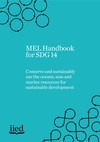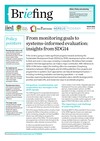Monitoring and evaluation guidance for SDG14
Despite the importance of marine resources to life on earth, Sustainable Development Goal 14 (Life Below Water) has struggled to gain attention and support on an international scale. This project provided guidance on how to develop and implement appropriate monitoring, evaluation and learning systems to support and accelerate progress towards achieving SDG14 and related goals.
Emilie Beauchamp was a senior researcher in IIED's Strategy and Learning Group until June 2022

A container ship off Pulau Bukom, Singapore. A case study in the Caribbean showed that reducing marine pollution will yield the most co-benefits across SDG targets (Photo: Ria Tan, Creative Commons, via Flickr)
The Sustainable Development Goals (SDGs) are one of the leading initiatives for addressing the critical, complex and often inter-related issues of our world. SDG14 – Life below water – focuses on our ocean, estuaries, rivers and watersheds, and the human systems that intersect with them.
Aquatic ecosystems are critical for achieving sufficient nutrition, economic growth, and livelihoods – especially for coastal communities. SDG14 is therefore deeply interlinked with progress towards goals 1, 2, 8, 11, 12, and 13. To maximise development outcomes from local to global levels, it is vital to monitor and evaluate policies and interventions under SDG14 to learn about the positive interactions with other goals and any potential trade-offs.
The 2030 Agenda for Sustainable Development encourages member states to conduct regular, country-driven progress reviews and evaluations to support their policies with evidence. Nationally-led exercises to monitor, review and assess benefits and complementariness at intersections of marine policies and other SDGs are essential to avoid negative unintended impacts in other sectors.
However reporting and evaluation exercises are still rare due to a lack of awareness and internationally established methodology. In fact, several SDG14 targets are classified as tier 3, making it difficult to evaluate overall progress. This gap reinforces the need for countries to use current guidance from international organisations (typically the United Nations) responsible for compiling and verifying country data and metadata to draw up high quality monitoring, evaluation and learning (MEL) systems that address their priorities.
Evidence from these processes also serve as a basis for regular Voluntary National Reviews (VNRs) by the high-level political forum, meeting under the auspices of the UN Economic and Social Council. Using evaluations to support more robust VNRs can ensure that reporting on indicators uses frameworks that are set and analysed within the context of national planning, decision-making and successful implementation.
Last, most of the methodologies used to produce data and information are concerned with the progress made against a specific goal. SDG14, just as all other SDGs, must be considered through more holistic assessments that take into account the integrated nature of sustainable development.
What did IIED do?
IIED developed a handbook to help national stakeholders and practitioners who work under SDG 14 to identify and develop appropriate (MEL) systems for their policies, projects, and interventions.
Based on a global survey and an international multi-stakeholder workshop, the handbook provides guidance on how actors in a variety of contexts can use MEL to understand which SDG14 targets and initiatives are working, which are not, why, for whom and how. The 'MEL handbook for SDG14' includes step-by-step guidance on how to assess progress towards them. The handbook:
- Contributes to the development of appropriate MEL systems and approaches, including linking local to national SDG14 strategies
- Assists in generating stronger evidence for advocacy, learning and reporting, and contributes to capacity-strengthening initiatives in MEL for SDG14, and
- Supports heightened cooperation and coherence in relation to measuring, understanding and accelerating progress towards SDG14 through participatory MEL approaches.
A briefing on how to achieve SDG14 was also published in March 2019. This included recommendations that development actors should maximise their chances of achieving SDG14 by integrating complex systems theory into their planning, implementation and evaluation processes, and focus on the systems they are trying to influence rather than specific projects and programmes.
News and updates
Publications
Additional resources
Video: Interview with Emilie Beauchamp about the SDG14 handbook
Blog: Focusing the blue economy future on small-scale fisheries, by Rosalind Goodrich (February 2019)
Blog: Green lessons for the blue economy, by Laura Kelly (December 2018)
Towards an inclusive blue economy, Essam Yassin Mohammed (2018), Project flyer







